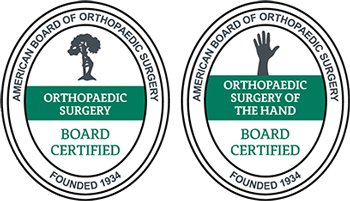Glomus Tumor
Contents
What are Glomus Tumors?
A Glomus Tumor is a rare, usually benign, soft tissue neoplasm. The glomus apparatus (or glomus body) is a part of the dermal layer of the skin and is thought to aid in temperature regulation. When exposed to cold temperatures, the glomus body moves blood away from the skin’s surface to reduce heat loss. While they are located all over the body, glomus apparatus are found in higher concentrations in the fingers and toes. Abnormal growth of a glomus body results in Glomus Tumors.
Glomus Tumors usually occur in people 20 to 50 but are more frequent in young adults. More common in women, 70% of Glomus Tumors are present in the hand, with the majority occurring underneath the nail bed. Most of the nodules are solitary but can occur in clusters. Glomus Tumors represent 1 to 5% of all soft tissue tumors in the hand and fingers.
What Causes Glomus Tumors?
The etiology of Glomus Tumors is unknown; however, they are thought to have a hereditary link.
What Are the Symptoms of Glomus Tumors?
Glomus Tumors usually present as a small, firm, reddish-blue bump underneath the fingernail. These lesions are usually quite small, less than 7mm in diameter. They can be extremely painful, sensitive to temperature change, and tender on palpation. The pain is often worse at night and can be relieved by applying a tourniquet. The mass can cause the nail bed to grow irregularly, with possible ridging.
How Are Glomus Tumors Diagnosed?
Glomus Tumors often require a specialist for accurate diagnosis. Upon examination, the mass may appear as a bluish lesion under the nail or in the fingertip pulp. There may be an abnormal ridge in the nail, swelling at the tip, and tenderness of the nodule to the touch. X-rays may show deformity or erosion in the distal phalanx if the mass is long-standing. Otherwise, the films may appear normal. MRI (magnetic resonance imaging) is the gold standard for diagnosis.

How Are Glomus Tumors Treated?
Surgical excision of the tumor is the only treatment modality. During a 15-minute outpatient procedure, the nail is removed, an incision is made into the nail bed, exposing the tumor, and the tumor is removed. The site is sutured, closed, and bandaged. Pain and cold intolerance symptoms are immediately relieved, and the nail will grow back to a normal appearance in 3 to 4 months.


How Can Dr. Knight Help You with a Glomus Tumor?
When it comes to this rare and complex finger tumor, it is important to find a surgeon who is well-versed in their treatment and who has seen many cases. Dr. Knight is one such surgeon, and he will bring his expertise to bear in your case, which will, no doubt, lead to a quick diagnosis after a long period of pain that has been difficult to diagnose.
Come visit Dr. Knight, one of the most accomplished hand specialists in Dallas, Texas. See him at the Southlake office or Dallas hand and wrist center.
Frequently Asked Questions:
Do I need surgery to get rid of a glomus tumor?
Unfortunately, due to the nature of glomus tumors and what they are made of, as well as where they are and how they are connected to the body’s surrounding tissues, surgery is the only viable option when it comes to having them removed. In the case of fingers, where they most commonly occur on hands, it is very important that the doctor carefully outlines the area of the tumor so that the incision is done precisely and carefully. The surrounding tissues are not excised in addition to the body of the tumor. Complete removal of the glomus body is key to ensuring the tumor doesn’t recur.
Is a glomus tumor cancerous?
Glomus tumors are exceedingly rare, accounting for perhaps 1% of all tumors, and of that small number, even fewer are cancerous, but there have been examples of glomus metastases that did harbor cancerous cells. Of these malignant glomus tumors, none have been recorded as occurring on the hands or fingers, but rather within the trunk of the body itself, on organs such as the spleen and the kidneys.
What can increase the likelihood of a glomus tumor?
The precise mechanisms through which a glomus tumor might arise are not very well understood, but doctors have determined that they are more common among women, and while there may be a possible hereditary link, no precise criteria have been isolated to determine their commonality among certain groups or association with other conditions.
Videos
Surgical Videos
Note: The following videos contain graphic images.
Disclaimer
HandAndWristInstitute.com does not offer medical advice. The information presented here is offered for informational purposes only. Read Disclaimer

























